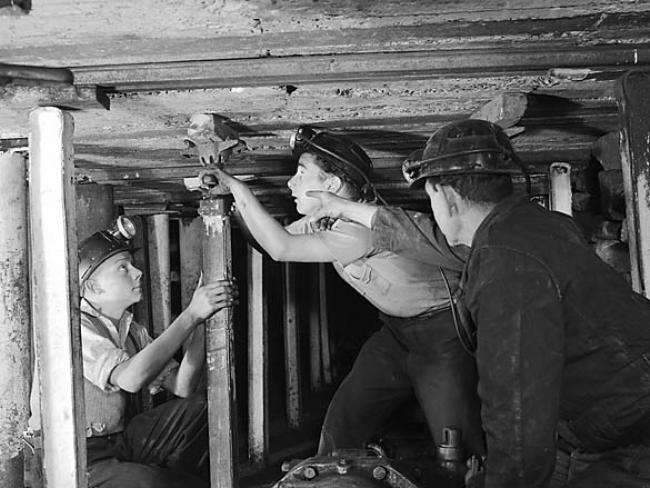
Miners being trained at the Aberaman training centre near Merthyr Tydfil, 1951. Photo Geoff Charles/National Library of Wales (public domain).
With another set of reforms to the NHS in prospect, it’s worth looking at what workers did for themselves in the past…
Before the Second World War, the great majority people of gained access to medical care as individuals. A comprehensive system did not exist to manage demand and to coordinate provision. And the quality and availability of health provision depended on income and relative poverty.
At the end of the nineteenth century medical care came through different routes; these did not change much until the National Health Service was introduced in 1948. About 5 or 6 per cent of the population relied on basic local provision through the Poor Law, and 10 to 15 per cent had free care from charitable institutions. The most common arrangement, used by about three-quarters of the population, was mutual aid. The remainder, less than 10 per cent, paid fees to private doctors according to income or used prepayment schemes based on a fixed annual fee.
Unlicensed
Outpatient departments of the voluntary hospitals were greatly used. A government survey of 1910 showed many people turned to unlicensed medical practitioners as well, including chemists, bonesetters, Christian Scientists, faith healers, abortionists and so on.
Social solidarity was always indispensable for working class communities if they wanted to make improvements or gain a better existence. Collective rather than individual initiatives were undertaken. These offered a greater chance of advance in a political landscape of profit-making. And so it was with medical treatment.
South Wales is a good example, and it provided one of the inspirations for the NHS. The area was heavily industrialised but had a boom and bust economy. That was mainly because it relied on a single industry – coal – which in turn depended on unstable and price-sensitive export markets.
The 1890s to the early 1920s saw a period of rapid expansion for coal. At its peak in 1921, the industry employed a quarter of a million men in Wales. But then came the recession as overseas markets began to shrink. Many pits closed and in others the owners sought to reduce costs by cutting wages, increasing hours and introducing mechanised cutting and conveyors. By 1933, employment in the industry was only half of the peak level.
The South Wales Miners’ Federation began in 1898. By 1914 it was the largest union in Britain, reaching 198,000 members in 1921. The centre of pit village life in the mining valleys was the union lodge which fostered collective responses to many community difficulties.
The miners elected their own leaders to the Boards of Guardians which administered Poor Law relief, which helped at times. For example at the end of the 1926 lockout the Bedwellty Board provided relief for destitute miners and their families against government instructions. These guardians were eventually removed by the government.
Unrivalled
Miners also set up health schemes such as the Tredegar Medical Aid Society. These varied in coverage but typically provided primary and secondary health care, dentistry and midwifery services for all subscribers and their families. This was unrivalled in Britain at the time for working people. And importantly management of the scheme was organised entirely by the mine workers themselves.
The Tredegar Workmen’s Medical Aid and Sick Relief Fund was founded in 1890. It brought together a number of schemes run by benevolent societies in the town and the Health and Education Fund that had been set up in the early 1870s by the Tredegar Iron and Coal Company.
There were a number of similar company-based schemes in South Wales at the time. Employees of mines, iron and coal firms paid a small proportion of their wages. In return they received medical care when required, for themselves and their families. The scope of cover varied from scheme to scheme.
‘Miners also set up health schemes such as the Tredegar Medical Aid Society…’
Following the merger of the town’s schemes and the combining of their funds, membership of the Tredegar Workmen’s Medical Aid and Sick Relief Fund increased, and by 1901 the Fund proposed that a hospital be built in the town. Built on land donated by Lord Tredegar and paid for by the Tredegar Iron and Coal Company, Tredegar Cottage Hospital opened in 1904 and was run by the Fund with weekly contributions from ironworkers. The influence of the company was quickly eroded with miners soon running affairs.
After the National Insurance Act of 1911 introduced unemployment benefit and sick pay, the Fund no longer provided sick pay. It became a benevolent society known as the Tredegar Workmen’s Medical Aid Society.
In the same year the society opened a Central Surgery equipped with consulting and treatment rooms, a pharmacy, a waiting room and accommodation for two doctors and their families. This was an important provision in a period where poverty was a reality or a frequent threat for a large majority of working people.
The society opened an office in the town and membership grew to more than 20,000. In 1925 it bought an old cinema and converted it into an extra surgery. By the 1930s the society was supplying medical aid to 95 per cent of the population – including members’ families and retired workers, employing five doctors and two dentists as well as pharmacists and nurses.
In the 30 years before the NHS existed the Tredegar Medical Aid Society catered for the medical needs of the people of Tredegar. The way it did so became a great source of inspiration for the creation of a national health service – notably the benefits of a health service free at the point of use.
• A longer version of this article is on the web at www,cpbml.org.uk
